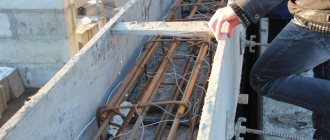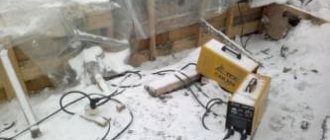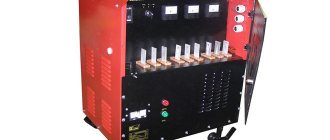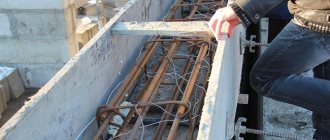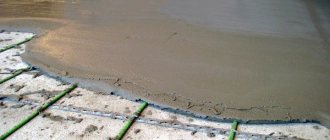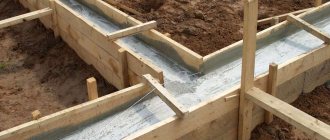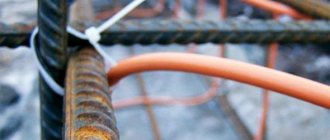Negative air temperatures are not a reason for downtime. Warming up the concrete mixture will help to obtain a material of brand strength. Construction work is carried out all year round. One of the main problems of winter construction is concreting.
Due to exposure to low temperatures, the hydration process in the concrete mixture may be interrupted, which will lead to a breakdown in the strength of the finished material. Therefore, warming up concrete in winter is a necessary and important point.
Warming up with electrodes
The most popular method of heating concrete is the use of electrodes. This method is relatively inexpensive, because there is no need to purchase expensive equipment and devices (for example, wire type PNSV 1.2; 2; 3, etc.). The technology for its implementation also does not present any great difficulties.
The fundamental principle of the presented technology is the physical properties and characteristics of electric current. As it passes through concrete, it releases some thermal energy.
When using this technology, you should not apply voltage to the electrode system above 127 V if there is a metal structure (frame) inside the product. The instructions for electrical heating of concrete in monolithic structures allow the use of a current of 220 V or 380 V. However, it is not recommended to use a higher voltage.
The heating process is carried out using alternating current. If direct current is involved in this process, it passes through the water in solution and forms electrolysis. This process of chemical decomposition of water will prevent it from performing the functions that the substance has during the hardening process.
How does construction work in winter?
Due to the physical properties of various building materials, low temperatures, and precipitation, construction in winter requires compliance with certain technologies, rules and measures necessary to achieve the required quality of work.
All construction projects cannot be completed without the use of concrete compounds. They are used at almost all stages of work. This and:
- Concreting the foundation.
- Production of monolithic supports.
- Installation of interfloor ceilings, etc.
But, as you know, any concrete mixture contains water, and this makes work much more difficult in winter. The need to combat its freezing (crystallization) creates a number of difficulties, but modern concreting technologies are able to cope with them.
How is concrete used in winter without losing its functions and properties? The answer is very simple - it is necessary to comply with the heating conditions of the concrete solution and maintain a positive temperature until it reaches its design strength.
Heating concrete using a heating cable
Usually a special PNSV wire is used (“Heating Steel Vinyl Wire” - meaning the core and sheath material), made from one steel core in PVC insulation; taken with a cross section of 1.2 mm.
Before pouring concrete, the wire is fixed to a frame made of reinforcement. The length of the sections and the pitch between them are determined based on the voltage of the transformer (at V=220V, the length is 110m, it decreases proportionally).
The amount of heat generated by the wires can heat the mixture to 60-70°C, with a consumption of 50-55 m of wire per 1 m³ of concrete mixture.
The power supply to the wires is carried out by a transformer device PPEB (3x380V), which can heat 20-25 m³ of the mixture.
The working conditions are as follows:
- The ambient temperature should not be lower than -25°C.
- Installation is carried out only when the wires are fixed.
- The wires should not touch each other; the minimum distance between them should be 15 mm.
- The connection points between the wire and the heater must be removed from the heating zone.
- Heating can begin after the concrete has been poured.
- Wells are made in the structure to provide access to the wires to control its temperature. If it exceeds the norm, the voltage in the network should be reduced.
Electrode heating.
This is the most popular technology for heating concrete. It is based on the release of heat during the passage of electric current through the concrete mass.
For this purpose, electrodes are placed in the laid concrete according to a certain pattern. The location of the electrodes must be such that the heat emitted by them is distributed evenly throughout the concrete mass.
Heating of concrete in winter is carried out at reduced voltage. The source of electric current can be step-down power transformers (single-phase or three-phase), with a voltage of the secondary windings from 50 to 127 V.
Power is set taking into account environmental conditions. At low temperatures, power increases. In order to maintain the concrete heating temperature at specified values, transformers are equipped with control devices that can be used to regulate the current value.
The heating mode is selected based on the types of electrodes used. The most popular types of electrodes are:
- rod electrodes. They are usually made from steel reinforcement. The layout and design step are determined in such a way that the heating areas overlap each other;
- plate electrodes. Such electrodes are surface plates made of roofing iron or steel. Placed on each inner side of the formwork. Each group of electrodes is connected to a different polarity (phase-zero). Thus, the current begins to flow through the concrete mixture from one polarity to the other. The heat released will heat up the concrete. Such electrodes are used for heating lightly reinforced structures of small sizes;
- strip electrodes. They are placed on one side of the structure. In this case, opposite poles of the electrical circuit are connected to nearby (adjacent) electrodes. This scheme provides peripheral heating of concrete. Electrode technology has found application in winter concreting of slabs, walls, floors with a thickness of no more than 20 cm; string electrodes. This type of electrode is used when heating concrete in winter in areas whose length is much greater than their cross-section (columns, racks, beams and other vertical structures). To achieve the optimal heating temperature, the string electrodes are located in the center of the structure. The phase wire is connected to them. To create a potential difference, the neutral wire is connected to the formwork. In this case, the formwork should be metal or wood sheathed with roofing iron. In some cases, the neutral wire is connected to the fittings. In this case, the reinforcing rods are also heated.
The following requirements apply to connection diagrams and electrode placements:
- the power of the installation must provide the time for heating the concrete to the hardening temperature;
- The connection diagram should be such that metal consumption can be reduced as much as possible. For this purpose, it is recommended to place the electrodes outside the heated structure;
- installation of a connection diagram for heating concrete in winter should be carried out before pouring begins.
Types of electrolytes for heating concrete in winter
Electrical heating of concrete is carried out using different types of electrodes.
Among them:
- String models. They are created from durable reinforcement, the length of which is 2-3 m, and the diameter is 10-15 mm. Suitable for columns and other vertical structures.
- Rod. Made in the form of pieces of reinforcement, 6-12 mm thick. Placed in the solution in rows. The calculation of the distance between the electrodes is determined experimentally. The first and last elements are connected to one phase, and the rest - to 2 and 3.
- Plate based. They are fixed on different edges of the formwork without immersion in the concrete mixture and operate from different phases. During operation, the elements form an electric field, under the influence of which the concrete warms up.
- Stripes. They are metal strips, 20-50 mm wide. They are placed on the surface of the solution and powered from different phases. Suitable for arranging floor slabs or other horizontal structures.
Concreting technology in winter conditions
As part of the work project, activities are developed that ensure:
- Preventing concrete mortar from freezing during transportation, laying and compaction.
- Prevention of freezing of freshly laid concrete until critical strength is achieved.
- Favorable heat and humidity conditions for strengthening of hardening concrete.
Preparation of concrete in winter. Measures to prevent freezing of ready-mixed concrete during transportation, placement and compaction
The finished concrete mixture supplied to the construction site must have a temperature of at least 5°C. To do this, mixing is carried out in warm (up to 70°C) water, and the filling materials are heated.
The cement is not heated to avoid welding. The transportation time of the finished concrete solution should not exceed 4 hours.
Surfaces for concreting and reinforcement must be heated close to the temperature of the concrete solution, for which warm or hot air is used, but not steam or water.
When transporting the finished concrete mixture for a long time and it is impossible to use heating, antifreeze additives are used.
Measures to prevent freezing of concrete before reaching critical strength
There are two main methods of winter concreting:
Cold concrete is concrete that will harden without heating. To ensure its hardening, special antifreeze additives are designed to reduce the freezing point of water and at the same time accelerate hydration reactions so that the amount of unbound water in the solution decreases as quickly as possible.
Widespread antifreeze additives are electrolytes, Na and K salts, but their use has some limitations:
- sodium salts are not used in reinforced concrete, as they lead to corrosion of the reinforcement;
- some types of Portland cement (for example, highly alkaline or made from clinker with a high content of aluminosilicates) are not used in conjunction with electrolytes;
- sodium and potassium salts are not used in mixtures with potentially reactive rock filler;
- electrolyte salts should be tested experimentally for the formation of efflorescence.
We connect the wire for heating the concrete PNSV
By using a heating cable for concrete, you can achieve a positive temperature of the mixture in the winter months. The method of performing the work is simple. A cable marked PNSV should be laid in the structure to be concreted and supplied with supply voltage from an electrical energy source.
This heating method is often preferred due to its serious advantages:
increased efficiency. A correctly laid heating cable, which is selected by calculation, can maintain the temperature necessary to harden a significant volume of concrete;
As a rule, power supply to PNSV cables is carried out through substations with several stages of reduced voltage
- efficiency. Electrical energy consumption is acceptable. This allows you to invest in the estimate of construction activities and prevent overspending;
- preservation of the concrete structure. When connecting the wire to a source of electrical energy, cracking of the concrete mass and the formation of air pores in it are excluded;
- versatility. Electric heating technology can be used for solid building structures that are made of ordinary or reinforced concrete.
Along with undeniable advantages, the technology also has weaknesses:
- requires preparatory work during which the wire is laid. The flexible cable for heating concrete requires care when placed in a reinforced structure and is laid according to the drawing;
- requires the use of a step-down transformer. The technical characteristics of the equipment for reducing the supply voltage should allow for smooth adjustment of the heating of the concrete mixture in the required range.
A specially designed wire is used, which consists of the following elements:
- conductor;
- protective insulation.
Cable selection is carried out after performing calculations taking into account the following parameters:
- transformer output voltage;
- cross-section of the conductive part;
- total length of the laid cable.
The temperature of the structure should not fall below the technologically determined minimum. When performing work, follow the following recommendations:
- lay the wire on a clean surface, avoiding damage;
- form cable loops evenly, avoiding kinks.
When purchasing PNSV wire, check the product’s compliance with the certificate. The reputation of the cable manufacturer plays an important role. The technology of using wire to heat a concrete mixture has much in common with the method of forming a heated floor.
Features of winter concreting
Is it possible to pour concrete in winter without heating? Experts say it is possible, but risky. Temperature is critical for concrete to gain strength. If a freshly laid concrete mass freezes, the water that has not reacted with the cement will turn into ice. This will lead to an increase in internal pressure. The fragile concrete structure will begin to collapse.
In the future, the ice may melt and the hydration process will resume, but the material will no longer gain the required strength.
To speed up the interaction of the components of the concrete mixture in winter, it is necessary to create and maintain optimal temperature conditions. To do this, you need to know how to warm up concrete in winter.
Many methods are proposed for solving such a problem. Their use is carried out in accordance with the approved rules: SNiP 3.06.04-91, SNiP 3.03.01-87.
Electromats
Thermoelectric construction mat (TEMS) also has a fairly simple design. However, unlike synthetic winterizers, it works on the “warm floor” principle. The designs of products of this type are equipped with graphite heating elements, due to which the concrete is heated.
TEMS allow you to raise the temperature of newly poured concrete to +70 °C (maximum value) and maintain it for several days.
After applying voltage to the polymer layer, it creates an IR radiation, which gradually begins to penetrate into the concrete to a depth of 60 cm. Thanks to the air layer and reflective material, heat loss is minimized.
If we talk about the advantages of thermoelectric mats for heating concrete, it is worth highlighting:
- the ability to warm up the solution even in difficult weather conditions;
- ease of use;
- heating, which is carried out over the entire concrete surface, thereby eliminating the risk of cracking of the monolith due to temperature changes;
- possibility of reusable use of products;
- the possibility of using mats simultaneously with other means of heating (for example, mineral wool or other lightweight insulation can be laid on top of the thermomat);
- low energy consumption (from 0.3 to 0.6 kW/m2).
However, in order for heating to be carried out efficiently, it is necessary to take into account some of the nuances of using TEMS.
How long does it take to heat concrete?
To save money, the heating time of concrete needs to be reduced to a minimum. But in each case, time is calculated separately, which is due to certain factors. These are the outside air temperature, the possibility and quality of thermal insulation, and the power of heaters.
Heating concrete with wire depends on how it is laid inside the structure and the power consumption. In general, the calculation of time depends on the temperature of the structure. In most methods, the monolith is heated to 60ºС, but this is done slowly, no more than 10 degrees per hour of heating. This ensures its uniformity, increasing the quality of the material. After the mixture reaches 50% strength, it is gradually cooled at an even lower rate of 5ºC per hour, using thermal insulation. Thus, warming up can take place over several hours or days.
What are thermomats
Heating mats are special devices that resemble blankets, thanks to which the concrete composition hardens at the temperature required for proper hydration.
The products consist of several layers:
- IR heating layer (made of polymer materials);
- a heat-insulating layer that is filled with air;
- several layers of special heat-reflecting material;
- moisture-resistant layer (made of PVC);
In addition, the device is equipped with special thermostats (bimetallic), which, when the desired temperature level is reached (up to +70 °C), turn off and start working again when the temperature drops to +60 °C.
Most often, infrared heating of poured concrete is carried out due to the power supply (220 V), which is supplied to the thermomat via a supply wire.
Depending on the operating principle, products are of two types: isothermal and thermoelectric.
Warming technology using PNSV
The principle of operation is quite simple: when voltage is applied, the wire heats up, which in turn heats the concrete mixture. Since it is recommended to limit heating to a voltage of 70 V, a step-down transformer (hereinafter referred to as PT) of appropriate power will be required.
Transformer substation KTPTO 80 for working with thermal conductor
Before installation, it is necessary to calculate the length of the heating wire
In this case, it is necessary to take into account its type and characteristics, the voltage of the transformer substation, the volume of the concrete mixture, the ambient temperature, as well as the nature of the structure (pouring of a column, beam is expected), etc. In order not to get confused in the calculations, you can use an online calculator to calculate the heating conductor PNSV or other cable (PNBS, PTPG, etc.)
To heat a concrete mixture with a volume of one cubic meter, about 1200-1300 W are needed. If we use a wire of this brand with a cross-section of 1.20 mm, then we will need a heating device of 30-45 m (to accurately calculate the length, you need to know the temperature conditions).
In addition, it is necessary to take into account the current strength; for normal operation of a cable immersed in a solution, 14.0 - 18.0 Amperes are permissible (depending on the connection diagram).
Electrical diagram for connecting PNSV A) star B) triangle
Warming up using a welding transformer and PNSV brand wires
As already noted, on an industrial scale or for large volumes of concrete work, special concrete heating technologies are used. But very often we have to solve the problem of laying concrete in winter conditions at home or during the construction of individual residential buildings and outbuildings. For such purposes, you can use a regular household welding machine.
For these purposes you will need the following equipment:
- household transformer welding machine with an operating current of 150-200 A;
- wires intended for heating concrete (PNSV);
- single-core electrical wire with aluminum conductors;
- measuring clamps.
The warm-up procedure consists of the following steps:
- Preparation of heating loops from PNSV wire. To do this, the wire is cut into separate sections. Each segment is marked. For example, one end of a segment is marked with white insulating tape, and the other with blue;
- fastening the segments to the reinforcement frame. The fastening must be above the middle of the plane being poured. It is recommended to tie the wire “snake-like”. The distance between individual loops is set depending on the outside air temperature according to the principle - “the lower the temperature, the shorter the distance”;
- The heating circuit is assembled. This is done with aluminum wire. To do this, all ends of the heating wire, marked with white insulating tape, are collected into one group and connected to the supply wire, which is connected to one of the poles of the transformer. The ends marked in blue are assembled in the same way and connected to the opposite pole. Thus, the scheme for heating concrete and reinforcement during winter concreting is ready for work;
- The welding machine turns on. In this case, first the current regulator is set to the lowest operating current;
- The measuring clamp determines the operating current in each of the loops. It should be no more than 12-14 A. If it differs from the specified value, then with the help of a regulator it is brought to normal.
- after an hour of operation, the loop current can be increased to 25 A;
- a schedule is drawn up for monitoring the warming up regime;
- Once the concrete has hardened, the voltage is turned off and the electrical circuit is disassembled.
Functional Features
The climatic conditions in our country are particularly harsh, so builders often have to work in freezing temperatures. It is precisely for those cases when it is urgently necessary to build a concrete structure, but the air temperature outside does not rise above zero, special devices have been created, the main task of which is to provide the very conditions necessary for the normal hardening of concrete.
How the device works
The transformer for heating concrete runs on electricity. Such devices are widely used by builders, as a result of which the construction of various concrete structures is significantly accelerated and simplified, especially in the cold season.
After preparation, the concrete mixture is heated by electricity, and the concrete itself, being connected to the electrical network, plays the role of a conductor. In this case, the energy is converted from electrical into thermal. This can occur directly in the cement mixture or on its surface. It all depends on the type of wires and electrodes used.
Using a transformer, concrete can be heated to a certain temperature in a certain period of time. The main thing is to choose the right current power. Those who use such equipment, of course, have the opportunity to choose one of several heating modes, which also increases productivity and makes work more efficient.
Such a transformer is suitable for heating a large volume of concrete mixture. If you need to build some small structure from concrete, then the use of this equipment is considered inappropriate.
Temperature sheet for heating concrete. Electrical heating of concrete structures with wire
When using concrete in construction, special attention is paid to the strength and durability of the material. In order for Concrete to acquire the necessary properties and qualities, it is necessary to follow the manufacturing technology
How to warm up concrete. 8 ways
When using concrete in construction, special attention is paid to the strength and durability of the material. In order for Concrete to acquire the necessary properties and qualities, it is necessary to follow the manufacturing technology
But it is known that the solution contains water.
Since it is not chemically bonded to the elements in the solution, freezing occurs when the ambient temperature drops. When water crystallizes, it increases in volume. As a result of the ongoing processes, additional stress is created in the concrete, which leads to the destruction of the material. For the Siberian region there are frosts in winter (see.
photo of concrete warming up in winter) is a common occurrence.
For approximately six months in Krasnoyarsk, unfavorable temperature conditions for concrete hardening remain and a temperature sheet for heating concrete should be used. But a simple method was found that allows construction work to be carried out during the cold period. This is warming up. If you use concrete heating (for more details, watch the video of concrete heating), then you can carry out work at subzero temperatures.
Therefore, PSK “Building” does not stop selling concrete in Krasnoyarsk even in winter. To maintain normal temperature conditions, several methods of heating concrete are used today. Here are the eight most effective: thermos; thermos with antifreeze additives and hardening accelerators; preheating the concrete mixture; electrode heating; heating in heating formwork; infrared heating; induction heating; heating with heating wires.
Among the listed methods, electrode heating is considered the most effective. But using only one method does not provide a guaranteed result. In most cases, complex measures are used. Let's take a closer look at each of the indicated methods. Thermos The technology consists of insulating the formwork. The type and degree of its insulation is selected based on the quality of the concrete and the ambient temperature.
The calculations are based on the requirement: when concrete is cooled to a temperature of zero degrees, it must gain critical strength. Thermos with antifreeze additives and hardening accelerators The meaning of the method is intuitively clear from the name. The essence is to combine the insulation of the formwork with the addition of certain chemical reagents that accelerate the hardening process and slow down the freezing process.
Preheating the concrete mixture This method consists of simply heating the mixture to a certain temperature. Heating is carried out before use - pre-heating. Electrode heating The essence of the technology is to pass electric current through concrete.
Due to this, the metal elements in the solution (rebar, special electrode) are heated, and as a result, the concrete itself is heated. Infrared heating The method is based on heating the surface under the influence of infrared rays. The heater works like the sun: it heats the illuminated surface, not the air around it.
Induction heating This technology is based on the generation of heat under the influence of eddy currents. Eddy currents are formed under the influence of an electromagnetic inductor. Heating with heating wires This method of heating involves pre-fixing special heating wires to the reinforcement of a concrete structure.
Current is then applied to the wires, causing the temperature to rise.
Electrical heating of concrete structures with wire
Currently, electrical heating of concrete structures with wire is becoming increasingly widespread in construction, used both to ensure the pouring of concrete in winter and to intensify the strength gain of concrete at other times. In this connection, I would like to bring to your attention a methodological guide on heating concrete with a wire for electrical specialists in construction organizations whose responsibilities include heating concrete structures.
Recommendations
The concrete heating cable can be wrapped around a steel frame, but tension must be ensured.- When it is laid between the elements of the metal frame, it must be taken into account that the wire should not touch the formwork and protrude beyond the concrete after pouring.
- The cable is installed only after the reinforcing frame has been laid.
- Also, you should not carry out work until the embedded parts are fenced.
- Warming up the concrete is not allowed after the strength has reached 50%.
- The cable should heat the concrete from approximately 40 to 80 degrees.
- Concrete gains strength in about three days.
- The warming up station operates on an intermittent or long-term basis.
- The distance between the wires should not be more than 15mm.
- The wires must not touch or cross.
- To control the temperature regime in the poured structures, special wells are made.
- The concrete must not be heated until the concrete is completely poured!
- It is better to entrust all work with concrete and electrical to specialists to avoid any mistakes.
The decision will be yours alone. We hope you found our article useful. Good luck!
Calculation of concrete heating
To calculate the length of the PNSV wire for one section, as well as the required number of such sections for a specific concrete structure, the technical characteristics of the wire itself and the operating voltage of the step-down transformer are taken into account. For example, with a voltage on a transformer of 220V, the length of one section of a PNSV wire with a cross-section of 1.2 mm will be equal to 110 meters. When the voltage decreases, there is a proportional reduction in the length of the cable section in the section.
Layout of electrodes in concrete
To begin calculating the empirical dependence of the average concrete temperature during cooling on the surface area, the following factors and calculations must be taken into account:
- Average annual weather forecast for winter in the region for several years. The predicted value of the average air temperature for the current winter period is also taken into account.
- The module of the working heated surface is calculated, and, based on these calculations, the corresponding thermos holding time of the solution is determined.
- Using the established formula, the average temperature of the structure during its cooling is calculated.
- Information is required on the temperature of the delivered ready-mixed concrete and its exothermic properties. These data can be obtained from the manufacturer.
- According to established formulas, heat losses during transportation of the mixture and its unloading are determined.
- It is also necessary to determine the temperature of the solution from the beginning of its laying, taking into account the heat transfer to warm up the formwork and reinforcement.
- Based on the regulatory requirements for the strength of concrete, the cooling time of the solution is calculated.
This method of calculation works when predicting the hardening time of concrete, taking into account heat losses when pouring the mixture, and heat radiation from the working surface, but such calculations are approximate.
Infrared heating
Infrared rays heat the surface of opaque objects, spreading heat throughout the entire volume. When using infrared heating, the concrete structure must be wrapped in a transparent film - it will retain heat by transmitting the rays through itself. Suitable for heating reinforced concrete.
Pros: simplicity and accessibility.
Cons: only suitable for small, thin structures; Infrared heat is distributed unevenly.
The infrared heater must be resistant to strong winds and capable of operating for a long time without refueling.
Conclusions:
- Electrode heating is suitable for a solution of any thickness and shape, but requires high energy consumption (about 1000 kW per 3–5 cubic meters).
- The contact method requires custom-made formwork and cannot provide uniform heating.
- The induction method is applicable exclusively with reinforced structures.
- Infrared heat can only heat a small layer of concrete.
The PNSV wire heats the mixture evenly and is safe to use: the cable is insulated, the temperature is easily regulated.
Our online store also offers diesel stations for heating concrete. You can find out how much the equipment costs taking into account the discount from our managers. Delivery costs depend on the dimensions and weight of the goods.
Source
Formwork for heating concrete
For this method, formwork is used, into the panels of which a heating element is inserted. The convenience of the design lies in the fact that, if necessary, you can easily replace its faulty elements. If the house is monolithic, then with the help of such formwork you can warm it up completely. If you warm up the floors in stages, then the formwork can be rearranged, moving on to the desired area of work. This method can be used even at an ambient temperature of -25 degrees.
The advantages of this technique:
- High performance with relatively low energy consumption;
- Requires little time for preparation and installation;
- Can be used in severe frosts;
- Can be used several times.
Flaws:
- High price.
- It is inconvenient if the structure is non-standard.
Infrared heating
This method is based on the principle of absorption of infrared rays by external bodies and their subsequent transformation into thermal energy. No intermediate devices are required to transfer heat from the source of infrared bodies. First, the surface of the object warms up, and then, due to its own thermal conductivity, the heat spreads throughout the internal structure. This heat exchange occurs almost instantly. For warming up, infrared generators have been used, the active element of which is metal or quartz tubular emitters. To ensure that the radiant flux is directed, the emitters are enclosed in aluminum reflectors with a flat or parabolic profile.
Infrared heating is used in the following cases:
- for heating reinforcement frozen to the base of concrete surfaces;
- to create thermal protection for the concrete mixture being laid; to speed up the hardening process of concrete when installing interfloor slabs;
- when installing walls using various types of formwork; during the construction of high-rise buildings using sliding formwork;
- when sealing rust between floor slabs;
- when creating thin-walled structures of buildings and structures.
Electrical energy can come from a 0.4 kV transformer substation or an autonomous source, such as a diesel power plant. Using a power cable, voltage is first supplied to the distribution board, and from it through protection devices to each emitter.
Benefits of infrared heating:
- no intermediate step-down transformer required;
- emitters operate at standard voltage 380/220 V;
- relatively low energy consumption.
Flaws:
- high cost of equipment for large volumes of concrete work;
- Infrared radiation removes moisture from the concrete mixture, which reduces the strength of the structure. To stop this process, cover the filling mirror with film.
Additional protections
To increase the strength of the concrete coating, various protective mixtures are sprayed onto its surface. They are white, black and colorless.
Black protects well from wind and direct sun, but its surface, on the contrary, increases heat absorption and overheats the concrete. Black bituminous mastic acts even worse; it evaporates a large amount of moisture during the wind. White additives, due to their color, reduce heat absorption, while colorless additives do not affect the appearance of concrete. Modern technologies have made it possible to obtain a product that creates a transparent film on the surface. This type of coating can be found on the floors of large hypermarkets. It involves improving the durability of concrete at average temperatures and humidity. But even when using such additives, one should not forget about the need to regularly moisten the coating.
Methods for heating concrete structures
Concrete is heated when working in the cold using various methods. Builders often use the following technologies.
Transformer
To warm up concrete in winter, many builders use a transformer. The heat generated by this technology produces an electrical current. Electrodes or wires are used with the transformer. The former are inserted into a pre-concrete structure or placed on its surface, and the latter are attached to reinforcement or immersed in the formwork, then the solution is poured. Electrodes and cables are connected to an electrical network with a voltage of 220 V or 380 V through a step-down transformer. Typically three-phase equipment is used. All phases must be loaded simultaneously.
Heating elements cannot be connected directly to the network. This will cause local overheating and can be life-threatening.
Electric heating of concrete with wire is a universal method. It can be used for walls, foundations, columns or floors. The following types of cables are allowed to be used for electrical heating of concrete using this technology:
- PNSV (heating with a steel core and vinyl insulation);
- VET (designed to operate directly from the electrical network);
- PTPZh (conductive with parallel galvanized conductors).
The wire cores can have a diameter of 1.2-3 mm.
If concrete is heated by a transformer using electrodes, the following types are suitable:
- strip;
- strings;
- rod;
- lamellar.
Infrared radiation
Another effective method of heating concrete in winter involves the use of infrared radiation, which is converted into thermal energy.
Industrial infrared heaters are placed next to the formwork filled with cement mortar and directed towards the formwork. The function of the radiation source is performed by heating elements with a power of up to several hundred kilowatts.
The infrared device has the following components:
- emitter;
- reflector;
- suspension or holder.
The required equipment power indicator must be selected in such a way that the surface temperature is no higher than 93 °C. The technique is not suitable if the concrete thickness is more than 70 cm.
The electric infrared method of heating the building mixture has high efficiency and low energy costs.
Warming up concrete on your own
Some simple techniques can be used in private construction, and heating equipment can be easily made with your own hands.
Magnetic induction method
Only reinforced structures can be heated using magnetic induction. Metal elements in this case turn out to be irreplaceable, since they act as a core. The insulated cable is placed in loops around the concrete-filled structure. It will act as an inductor. Which wire to use and how much of it is required is determined through calculations. Then alternating current is passed through the cable. The magnetic field formed as a result of the described manipulations heats the reinforcement of the reinforced concrete structure, from which the heat spreads throughout the concrete composition. And winter is no longer an obstacle to continuing construction work.
Heating is done from outside. The advantages of induction heating using the induction method are low cost and uniform heating. The disadvantage is that it can only be used on a small list of structures - beams, columns, etc.
Heating formwork
In some cases, heating formwork is used for concreting in cold weather. It can also be used in the summer to reduce the rate of hardening of the solution. The standard components of such formwork are supplemented with heating elements. The scheme of such a modification is quite simple. Both wooden and metal formwork can be used for heating.
It is allowed to use not only wires and cables as heating elements, but also tubular, tape electric heaters, and conductive films. The size of the heating elements is calculated individually. The use of heating formwork ensures uniform heating, and installation of the structure takes a minimum of time.
Teplyakom
One of the oldest proven methods of heating concrete mortar involves the use of greenhouses (or tents). The technology consists of creating a thermally insulated space around the structure being filled with the composition. The latter is then heated to the required temperature using heat guns or heaters. The greenhouse can be made from tarpaulin, wood or polymer materials with suitable characteristics. Only a separate part of the entire structure, which is poured, is subject to covering. The tent is then moved.
Shelter and heat guns
The technology is quite simple - a tent is built over the desired area and heat is pumped in using heat guns. A fairly common old-fashioned method of heating the foundation with hot air. Used in small construction areas, a labor-intensive process associated with the construction of a heat-retaining dome.
If you want to heat concrete with a heat gun, keep in mind that this will be a rather expensive option. The only advantage of this technique is the ability to heat the concrete screed without electricity. There are autonomous heat guns, most often diesel. If there is no access to a 220 volt network, this heating option will be the most advantageous.
You can clearly see this heating method in the video:
Using heat guns

